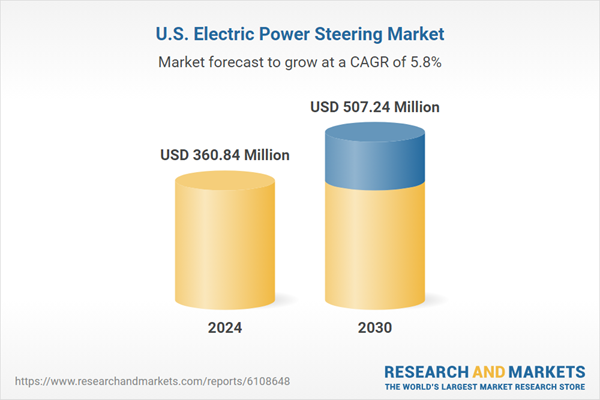Speak directly to the analyst to clarify any post sales queries you may have.
10% Free customizationThis report comes with 10% free customization, enabling you to add data that meets your specific business needs.
Key Market Drivers
Fuel Efficiency and Environmental Concerns
One of the primary forces propelling the growth of the U.S. Electric Power Steering (EPS) market is the automotive industry's focus on fuel efficiency and environmental impact reduction. According to the EPA’s 50th Annual Automotive Trends Report, average vehicle fuel economy reached 27.1 mpg, a 1.1 mpg improvement from the previous year. EPS systems contribute to this progress by eliminating the hydraulic pump used in conventional systems, thereby reducing parasitic engine load and improving overall energy efficiency. As automakers work to meet stricter emissions regulations and consumers become more environmentally conscious, EPS is being increasingly adopted for its ability to reduce fuel consumption and contribute to greener mobility solutions.Key Market Challenges
Technical Complexity and Maintenance Challenges
The integration of EPS systems brings notable technical challenges for manufacturers and service providers. These systems include multiple electronic components such as sensors, actuators, and control units, which require precise coordination for optimal performance. Diagnosing issues can be more complex than with hydraulic systems, often requiring advanced diagnostic tools and specialized technical expertise. Maintenance and repairs may be more costly and time-consuming, and in many cases, software updates are needed to ensure continued functionality. For consumers, this can translate to increased service center visits and higher ownership costs, especially in cases where independent repair shops lack the necessary equipment or training.Key Market Trends
Integration with Advanced Driver Assistance Systems (ADAS)
The growing integration of Electric Power Steering with Advanced Driver Assistance Systems is a defining trend in the U.S. EPS market. Features such as adaptive cruise control, automated emergency braking, and lane-keeping assist rely on responsive and precise steering systems. EPS technology enables fine steering adjustments required by these ADAS functions, enhancing both vehicle safety and driving comfort. For example, EPS systems assist lane-keeping by gently guiding the vehicle back within lane boundaries, while adaptive cruise systems use EPS for steering input adjustments based on surrounding traffic. This compatibility with autonomous technologies is accelerating EPS adoption as vehicles evolve toward higher levels of automation.Key Market Players
- Mitsubishi Electric Corporation
- Robert Bosch GmbH
- Denso Corporation
- JTEKT Corporation
- NSK Ltd.
- thyssenkrupp AG
- ZF Friedrichshafen AG
- Knorr Bremse AG
- Dowlais Group Plc (GKN Automotive Ltd.)
- Nexteer Automotive Corporation
Report Scope:
In this report, the United States Electric Power Steering Market has been segmented into the following categories, in addition to the industry trends which have also been detailed below:United States Electric Power Steering Market, By Type:
- C-EPS
- P-EPS
- R-EPS
United States Electric Power Steering Market, By Component Type:
- Steering Column
- Steering Wheel
- Sensors
- Electronic Control Unit
- Electric Motor and Bearings
United States Electric Power Steering Market, By Vehicle Type:
- Passenger Cars
- Medium & Heavy Commercial Vehicles
- Light Commercial Vehicles
- Off-the-Road Vehicles
United States Electric Power Steering Market, By Mechanism Type:
- Collapsible EPS
- Rigid EPS
United States Electric Power Steering Market, By Region:
- South
- West
- Mid-West
- Northeast
Competitive Landscape
Company Profiles: Detailed analysis of the major companies present in the United States Electric Power Steering Market.Available Customizations:
With the given market data, the publisher offers customizations according to a company's specific needs. The following customization options are available for the report.Company Information
- Detailed analysis and profiling of additional market players (up to five).
This product will be delivered within 1-3 business days.
Table of Contents
Companies Mentioned
- Mitsubishi Electric Corporation
- Robert Bosch GmbH
- Denso Corporation
- JTEKT Corporation
- NSK Ltd.
- thyssenkrupp AG
- ZF Friedrichshafen AG
- Knorr‑Bremse AG
- Dowlais Group Plc (GKN Automotive Ltd.)
- Nexteer Automotive Corporation
Table Information
| Report Attribute | Details |
|---|---|
| No. of Pages | 88 |
| Published | July 2025 |
| Forecast Period | 2024 - 2030 |
| Estimated Market Value ( USD | $ 360.84 Million |
| Forecasted Market Value ( USD | $ 507.24 Million |
| Compound Annual Growth Rate | 5.8% |
| Regions Covered | United States |
| No. of Companies Mentioned | 10 |









